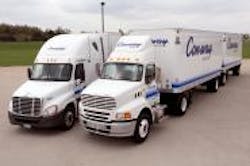“Just getting 100 extra pounds of freight on our trailers equals $6.5 million in extra revenue per year; that’s why logistics equipment like this is so critical.” –Mark Arnold, project manager for LTL carrier Con-way Freight, discussing the Lift-A-Deck II system offered by Ancra International
There’s been a ton of discussion in recent months revolving around trucking capacity in one form or another.
For starters, the need for truck freight capacity is rising while the industry remains very reluctant – and understandably so – to expand their operations to meet growing demand. Trailers aren’t cheap (trucks certainly aren’t, either), and after the “Great Recession,” few want to risk precious dollars on assets that could one day again sit idle.
On another level, efforts on Capitol Hill to boost federal weight limits for big rigs from 80,000 to 97,000 pounds continues to face stiff opposition from any number of groups, bogging down efforts to boost truck productivity while reducing the number of truck on the road and cutting fuel use, too.
That’s why the detailed results of a two-year study on the part of LTL carrier Con-Way Freight discussed at the 2011 Technology & Maintenance Council (TMC) annual meeting regarding the Lift-A-Deck II load maximizing system developed by Ancra International offer an interesting solution of sorts to this growing capacity issue.
Now, “Lift-A-Deck” isn’t a new “logistics equipment” package by any means: Ancra’s had this out there since 2002, and updated it as well (hence the “II” in the product’s name). The difference is that Con-Way Freight took a long, deliberate in-depth look at this system in its LTL operation to really see if such an “inside the box” solution could really pay handsome dividends in terms of boosting available capacity without having to buy more equipment.
Marketed by Con-Way under the name “SafeStack” and now being added to all of the carrier’s 16,800 LTL trailers, the “Lift-A-Deck II” proved itself over the course of the two-year study begun in April 2009, helping Con-Way boost its load factors by 25% while cutting its “delivery exception” ratio – a code word for cargo claims due to damage caused during transit – by 50%.
The technology proved out so well in Con-Way’s eyes that its Con-Way Truckload division is now also using it on 100 of its 53-foot trailers, under the private label brand “DoubleStack.”
[Here’s a short video showing how Ancra’s “Lift-A-Deck” system works.]
Basically, Ancra’s system creates multiple decking “platforms” for both palletized and non-palletized freight within a trailer, using narrow, low-profile, aluminum aircraft-style cargo tracks and aluminum beams. The tracks’ sloping shoulders reduce the chance of forklift damage and attach to the trailer’s vertical structural posts every 16 or 24 inches, becoming an integral part of the sidewall structure.
When not in use, the shoring beams retract to the trailer ceiling, occupying just 6 inches of the ceiling space. That’s important, Mark Arnold, Con-way’s project manager, told me, because after analyzing some 105,000 loaded trailers he found on average a “full load” still leaves 8 inches of ceiling space unoccupied.
“The other concern revolved around losing trailer ‘width’ due to the tracks,” he added. “But we spec a 1-inch scuff liner around the floor of our trailer – and the tracks for Ancra’s system only extend out half an inch. So in reality, we don’t lose either height or width by installing this logistics equipment.”
Ancra noted that the standard “Lift-A-Deck” shoring beams offer a working load limit of 2,200 pounds, with heavy-duty beams available that are rated for a working load limit of 3,000 pounds. To carry freight that’s not packed on a pallet, Con-way places plywood boards across the beams, which will chanover to specifically-deigned plastic flooring crafted to “lock” into the beams for easier use.
The patented system is applicable to all manner of trucking trailer models, said Ralph Abato, Ancra’s vice president of sales and marketing, from typical 28-foot “pup” trailers used by national LTL carriers, as well as 45- and 48-foot city vans, and 53-foot trailers used in the long-haul TL sector.
Now, of course, other issues arise when stacking freight in a system like this. Obviously, it significantly raises the center of gravity for the trailer, so drivers must be extra cautious when making turns. (It’s always wise to put the heavier freight on the floor of the trailer and the lighter freight on the decking beams … but that is pretty much a no brainer … I hope ...)
“We haven’t had any rollovers due to the system, and little damage to the components after almost two years of use,” Con-way’s Arnold said. “I credit all of that to the due diligence of our drivers and dock workers.”
That lack of damage is important, for while it’s inexpensive to repair, “Lift-A-Deck” is not cheap to buy. For a 53-foot trailer, installing the “Lift-A-Deck” system costs $4,000 to $5,000 a pop, Ancra noted, and it can take about 8 hours to install. The system also weighs about 700 to 1,100 pounds fully installed, so that has to be taken into account within the trailer payload calculations.
That being said, though, compare that to the $40,000 or more a fleet would spend on getting a single new trailer -- and that being able to haul incrementally higher loads of freight can generate a fairly quick return on investment (ROI) too.
“For us, as an LTL carrier, the pay off can accumulate quickly,” explained Con-way’s Arnold. “Depending on what kind of freight we’re getting an opportunity to haul, we could pay it off in two or three trailer ‘runs’ so to speak. Just getting 100 extra pounds of freight on our trailers equates to $6.5 million in extra revenue per year; that’s why logistics equipment like this is so critical.”
Pretty good result for thinking inside the box, if you ask me.
